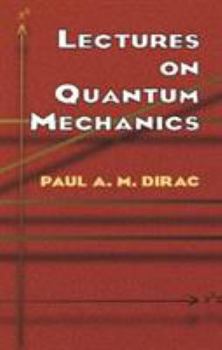Lectures on Quantum Mechanics
Select Format
Select Condition 
Book Overview
The author of this concise, brilliant series of lectures on mathematical methods in quantum mechanics was one of the shining intellects in the field, winning a Nobel prize in 1933 for his pioneering work in the quantum mechanics of the atom. Beyond that, he developed the transformation theory of quantum mechanics (which made it possible to calculate the statistical distribution of certain variables), was one of the major authors of the quantum...
Format:Paperback
Language:English
ISBN:0486417131
ISBN13:9780486417134
Release Date:March 2001
Publisher:Dover Publications
Length:96 Pages
Weight:0.30 lbs.
Dimensions:0.3" x 5.4" x 8.5"
Customer Reviews
5 ratings
A necessary book for those who love quantum mechanics
Published by Thriftbooks.com User , 14 years ago
I have no doubt: this is a necessary book for those who love quantum mechanics.
Short and good
Published by Thriftbooks.com User , 16 years ago
This book is really fun it contains a series of lectures given by Dirac, although it is really really short it is well worth its price because it gives you a good view in the problems of Quantum Mech of the time
A must have
Published by Thriftbooks.com User , 17 years ago
From the master himself: Paul Dirac. Very sharp, to-the-point and complete overview of the Quantum Theory. But from Dirac's point of view it's an interesting angle to review things.
Quantization
Published by Thriftbooks.com User , 20 years ago
The concept of 'quantization' has acquired multiple meanings in mathematical physics, since the foundation of quantum mechanics in the 1920ties. I refer to the papers of Heisenberg, Schrodinger, and Dirac which made precise the variables: states, observables, probabilities, the uncertainty principle, dual variables, and the equations of motion. This was also when the wave-particle question received a more precise mathematical formulation, and resolution. Perhaps best known are the equation of Schrodinger, giving the dynamics of systems of quantum mechanical particles, and Dirac's equation for the electron. All three of the pioneers won the Nobel Prize at a young age;-- Schrodinger was a little older than the other two (Heisenberg and Dirac were both born in 1902.) In 1932, John von Neumann showed, surprisingly at the time, that Schrodinger's formulation is equivalent to Heisenbergs matrix mechanics, and von Neumann turned quantization into a field of mathematics. Von Neumann was a contemporary, but trained in mathemetics. His 1932 book "Mathematical Foundations of Quantum Mechanics" was reprinted by Princeton University Press in 1996. Occasionally the link to the foundations of physics have been missed: Reed and Simon quote Edward Nelson: "First quantization is a mystery, and second quantization is a functor." Dirac's lovely little book represents a set of lectures Dirac gave in 1964 at Yeshiva University, at a time when the great master could take advantage of hindsight. The Dover edition didn't appear until 2001. The clarity of Dirac's presentation is truely compelling (no mystery at all!). Very little background is required on the part of the reader. Dirac begins with the Hamilonian method, and then passes to quantization in terms of physics. The mathematics of quantization on curved (and flat) surfaces is clearly presented in the second part of the book. Dirac's ansatz for relativistic theory is Lorentz invariance, and the equations of motion arise naturally as extensions of the 'classical' theory. The Lorentz-invariant action integrals are central, and Dirac covers the Born-Infeld electrodynamics in the last chapter. In total the book is only 87 pages, but Dirac is the master of effective and consise exposition. He also firmly believed that, as a rule, the beauty of the mathematics involved is a good indication that the equation is right for physics. Readers who enjoy popular books by the pioneers in science might like to check out Schrodinger's "What is Life?" reprinted by Cambridge University Press 2002, with a Preface written by Roger Penrose, and a lovely set of biographical sketches, written by Schrodinger, and translated by his granddaughter Verena. And there is a lovely book edited by Pais, Jacob and Atiyah, "Paul Dirac: The Man and his Work" , Cambridge U Press, 1998. ---Review by Palle Jorgensen, July 2003.
Quantization with constraints- a very advanced text
Published by Thriftbooks.com User , 22 years ago
This is a very important book. In it Dirac reviews his modified Hamiltonian formalism, including constraints, so that systems which do not have a proper hamiltonian can be canonically quantized anyway. For Dirac sustains that one only knows how to quantize a system when it has a Hamiltonian. So, if the system doesn't have one, what is a guy to do? He teaches how to generalize the canonical formalism and construct an effective Hamiltonian which is sufficient to do the job. These ideas gave origin to a flow of papers dealing with the matter, and to several good books. Still, Dirac's original lectures are the best introduction, in my opinion. Not to be confused with the famous "Principles of Quantum Mechanics" , the great expository classic. This book I am reviewing is more of a research document.




